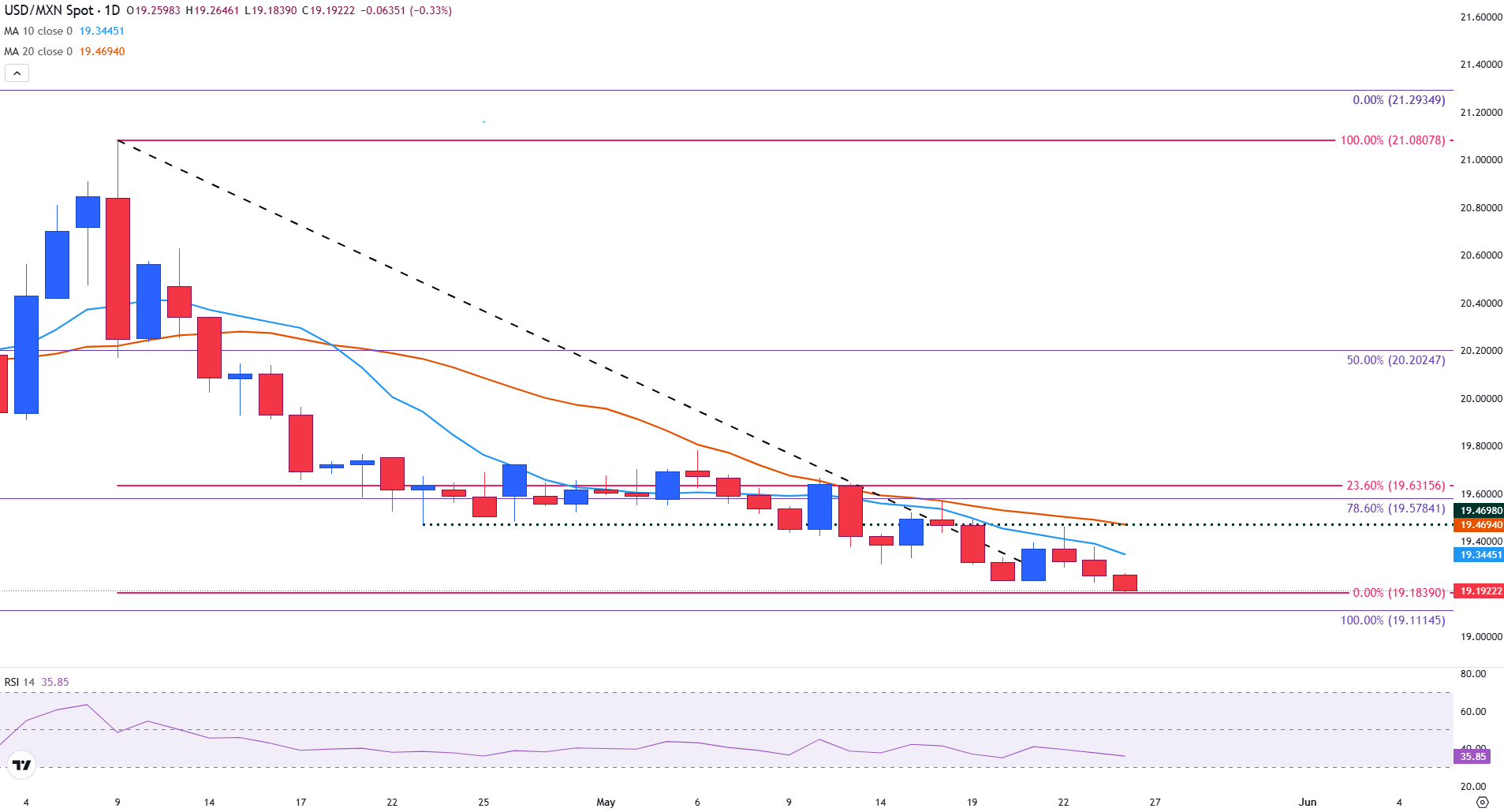Mexican Peso trades at a new YTD high against the US Dollar on US Memorial Day
- The Mexican Peso keeps firm against the USD Dollar, marking a fresh year-to-date high.
- US markets remain closed for Memorial Day, with low liquidity expected throughout the day.
- USD/MXN faces renewed pressure, testing 19.20 as focus shifts to Friday’s US PCE print.
The Mexican Peso (MXN) is experiencing a steady appreciation against the US Dollar (USD) on Monday, reflecting lingering uncertainty in the United States (US) economic outlook amid concerns about US President Donald Trump’s tariff threats and the country’s fiscal outlook.
With US markets closed for Memorial Day on Monday, the Mexican Peso remains resilient, with the USD/MXN pair trading at around 19.19, down 0.33%, at the time of writing.
As participants keep an eye on US Treasury yields and remarks from US policymakers, they should be aware of the limited liquidity in the US market due to the holiday weekend.
On this week’s economic agenda, the fate of the USD/MXN will likely remain at the mercy of the Greenback and insights provided by the Fed meeting minutes on Wednesday.
Market participants are particularly focused on the release of the Fed’s preferred inflation measure, the US core Personal Consumption Expenditures (PCE) data for April, as well as the University of Michigan consumer sentiment data, which are scheduled for Friday.
These data points are crucial for understanding inflation and consumer sentiment trends, and gauging how US citizens feel about the current economic situation, both of which are important factors that may influence expectations regarding when the Federal Reserve (Fed) might consider cutting interest rates.
Mexican Peso daily digest: USD/MXN faces pressure due to renewed US Dollar weakness
- The US credit rating downgrade, rising expectations of increased US debt levels, and a sell-off in the bond market have placed the resilience of the USD under significant scrutiny.
- The USD struggles to gain ground as investors digest US President Donald Trump’s decision to extend EU tariffs until July 9. The announcement on Monday cheered risk markets, as traders see it as an opportunity for negotiations between the two significant economies.
- On Friday, Trump had threatened to impose 50% tariffs on European Union imports and 25% tariffs on Apple and Samsung smartphones, rattling markets.
- The persistent threats of tariffs from President Trump directed at international counterparts are undermining investor confidence, thereby challenging the USD's status as the preferred reserve currency.
- On Tuesday, US Consumer Confidence data, which gauges Americans’ views about the economy and finances, will be released.
- Wednesday’s agenda will see the publication of the minutes from the May Federal Open Market Committee (FOMC) meeting, offering insights into interest rate discussions, alongside public statements from Fed members providing additional context for future monetary policy.
Mexican Peso technical analysis: USD/MXN pressures support with October low in focus
USD/MXN remains entrenched in a firm downtrend, hitting a new year-to-date low just below 19.20 at the time of writing.
Price action continues to hover below both the 10-day and 20-day Simple Moving Averages (SMA), which act as dynamic resistances at 19.34 and 19.47, respectively.
Momentum indicators remain weak, with the Relative Strength Index (RSI) parked at 35.79, suggesting that while bearish momentum, the market is not yet in oversold territory.
With downside pressure building, attention now shifts to the October low at 19.11, which serves as the next major support.
A sustained break below this level could open the door to deeper declines toward 19.00, while any rebound would first need to reclaim 19.47 to shift short-term sentiment.
USD/MXN daily chart

US Dollar FAQs
The US Dollar (USD) is the official currency of the United States of America, and the ‘de facto’ currency of a significant number of other countries where it is found in circulation alongside local notes. It is the most heavily traded currency in the world, accounting for over 88% of all global foreign exchange turnover, or an average of $6.6 trillion in transactions per day, according to data from 2022. Following the second world war, the USD took over from the British Pound as the world’s reserve currency. For most of its history, the US Dollar was backed by Gold, until the Bretton Woods Agreement in 1971 when the Gold Standard went away.
The most important single factor impacting on the value of the US Dollar is monetary policy, which is shaped by the Federal Reserve (Fed). The Fed has two mandates: to achieve price stability (control inflation) and foster full employment. Its primary tool to achieve these two goals is by adjusting interest rates. When prices are rising too quickly and inflation is above the Fed’s 2% target, the Fed will raise rates, which helps the USD value. When inflation falls below 2% or the Unemployment Rate is too high, the Fed may lower interest rates, which weighs on the Greenback.
In extreme situations, the Federal Reserve can also print more Dollars and enact quantitative easing (QE). QE is the process by which the Fed substantially increases the flow of credit in a stuck financial system. It is a non-standard policy measure used when credit has dried up because banks will not lend to each other (out of the fear of counterparty default). It is a last resort when simply lowering interest rates is unlikely to achieve the necessary result. It was the Fed’s weapon of choice to combat the credit crunch that occurred during the Great Financial Crisis in 2008. It involves the Fed printing more Dollars and using them to buy US government bonds predominantly from financial institutions. QE usually leads to a weaker US Dollar.
Quantitative tightening (QT) is the reverse process whereby the Federal Reserve stops buying bonds from financial institutions and does not reinvest the principal from the bonds it holds maturing in new purchases. It is usually positive for the US Dollar.

